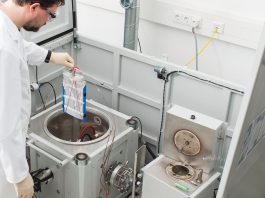Novel research at the Chalmers University of Technology outlines a new theory for developing cement-based rechargeable batteries.
The pioneering concept from researchers at the Swedish University’s Department of Architecture and Civil Engineering, published in the journal Buildings, entails a cement-based mixture, with a small quantity of short carbon fibres used to heighten the conductivity and flexural toughness. Added to this is a metal-coated carbon fibre mesh, with iron for the anode and nickel for the cathode.
The findings could make the idea of an entire twenty storey concrete building which can store energy like a giant battery a reality.
Together, Professor Luping Tang’s research group and Dr Emma Zhang have successfully developed the innovative concept.
Zhang explained: “Results from earlier studies investigating concrete battery technology showed very low performance, so we realised we had to think out of the box, to come up with another way to produce the electrode. This particular idea that we have developed – which is also rechargeable – has never been explored before. Now we have proof of concept at lab scale.”
The team have developed the rechargeable battery with an average energy density of 7 Watthours per square metre (or 0.8 Watthours per litre). This is lower than the energy density in commercial batteries, however this restriction could be surmounted as a result of the massive volume at which the battery could be constructed when used in buildings.
This rechargeable battery could have further applications, such as powering LEDs, providing 4G connections in remote areas, or cathodic protection against corrosion in concrete infrastructure.
“It could also be coupled with solar cell panels for example, to provide electricity and become the energy source for monitoring systems in highways or bridges, where sensors operated by a concrete battery could detect cracking or corrosion,” indicated Zhang.
The notion of utilising structures and buildings in this way could be groundbreaking, as it would present an alternative resolution to the energy crisis, by delivering a huge volume of energy storage.
Concrete is the world’s most frequently used building materials but is currently less than perfect from a sustainability point of view. However, the possibility of adding functionality could present a new dimension.
“We have a vision that in the future this technology could allow for whole sections of multi-storey buildings made of functional concrete. Considering that any concrete surface could have a layer of this electrode embedded, we are talking about enormous volumes of functional concrete,” Zhang commented.
This cement-based rechargeable battery concept is still at its early stage, as technical questions must be resolved before the vision can implemented on a commercial level.
Zhang added: “Since concrete infrastructure is usually built to last fifty or even a hundred years, the batteries would need to be refined to match this, or to be easier to exchange and recycle when their service life is over. For now, this offers a major challenge from a technical point of view.
“We are convinced this concept makes for a great contribution to allowing future building materials to have additional functions such as renewable energy sources,” concluded Tang.









